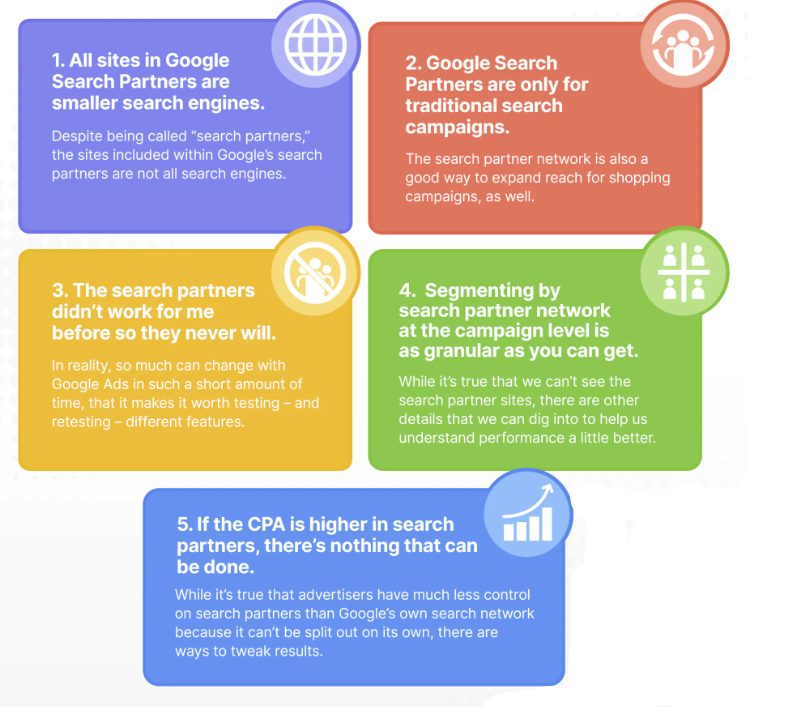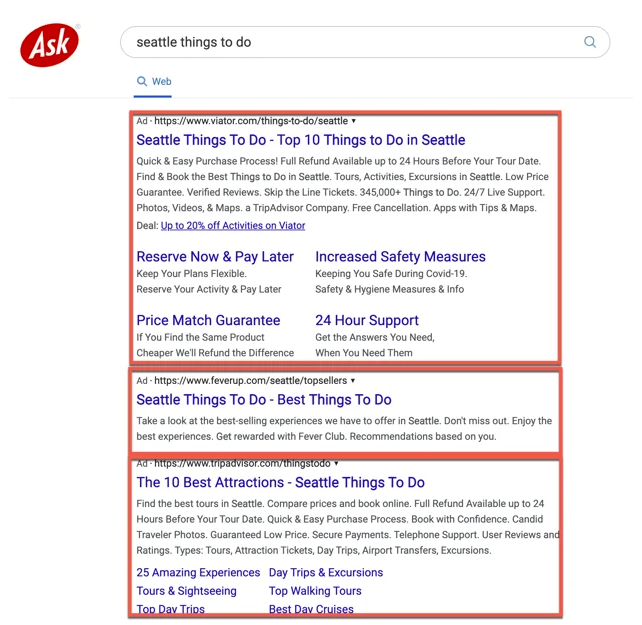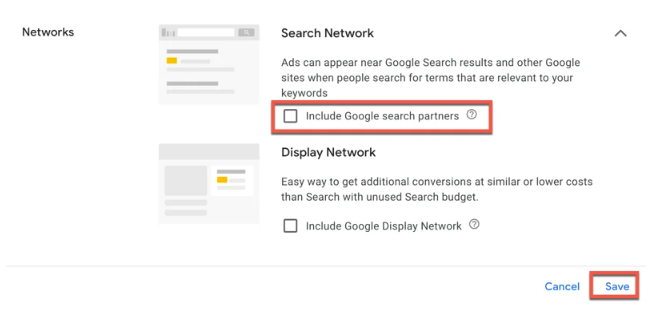When it comes to Google advertising, the Google Search Partners Network is probably one of the more under-discussed tools it offers.
Businesses and brands often wonder — with good reason — if the pros are worth it for the potential cons. After all, there is a certain level of ambiguity to it, and there’s far less control over ad placement on Google Search Partners than on Google proper. This uncertainty is exacerbated by the fact that Google doesn’t give a full list of sites or apps within this network, meaning your ads could show up on the most irrelevant sites which can affect the overall lead quality.
Now, before we dive into the arguments for and against, let’s look at what Google Search Partners Network actually is and how it works.
What is Google Search Partners Network?
The Google Search Partners Network is a collection of websites and apps with search functionality where your ads can appear. By partnering with Google, these sites and apps have agreed to have your ads appear when someone uses their own search functions.
If you, as a marketer, opt-in to Google Search Partners Network, it means your ads can show not just on Google proper, but on these associated sites and apps, and often resulting in unqualified leads and irrelevant ad and site traffic.
Whether you decide if it’s right for you or not depends on a few factors, namely your budget and target audience, but also your campaign goals.
The clear advantage of Google Search Partners is how it ends up expanding your reach beyond just Google, but there are downsides as well. Which, on that note…
Cons of using Google Search Partners Network
Source: searchengineland.com
The primary drawback of using Google Search Partners Network is simply that you don’t have the same level of control on search partners’ sites regarding ad placement and visibility. That is because you’re either advertising on the network or not and don’t have the ability to pick and choose sites, your ads could show up on, umm, less appropriate ones.
In this scenario, not only do you have no control over your ads’ placement, but that also can implicitly have a negative impact on the quality of traffic, as mentioned previously. And, not to mention there are some sites within the network that you probably don’t want to associate with.
Due to your lack of control over ad placement on different network partners, there are probably lots of sites that aren’t particularly relevant for your purposes — but your ads can still be shown there.
This means a disproportionate amount of the traffic from that site will be pretty low quality, likely resulting in greater bounce rates and fewer conversions. It also means it can be difficult to project your results based on traffic; if you’re relying on accurate projections, the Google Search Partners Network is gonna be really tricky. This also means the default broad match keywords tend to perform poorly here.
Lastly, another unintended consequence of these side effects is that it can be less than stellar for your budget. Your limited control and lack of bid adjustments means less precision, worse targeting, and more interactions from users who aren’t particularly relevant to your end goals — but for whom you’re getting charged anyway.
Source: seerinteractive.com
Due to those factors, your budget can get drained quickly without too much to show for it, resulting in a low ROAS.
With those forewarnings in mind, there are some good arguments for Google Search Partners too:
Pros of using Google Search Partners Network
Source: seerinteractive.com
First off: This probably sounds ridiculous after we just warned about how advertising in search partners can drain your budget, but it can, paradoxically, be cheaper depending on your priorities, goals, and approach.
This is because Google Search Partners’ ads are generally competing with fewer other bids — this means there’s less competition and cheaper costs per click. It also can give you good insight into your site’s traffic, allowing you to better deduce what terms people are more often converting on or interacting with, all at a cheaper cost.
Yeah, the “Google Search Partners Network is cheaper” and the “you can blow all your money on Google Search Partners Network” statements have to be reconciled, so we’ll boil it down to this: With the far lower amounts of competition, you can get a lot more for less — but that you should be extremely diligent about not just chucking money at Google Search Partners ads and letting it go or else you’ll likely end up with cheap per-click responses.
Further, even when you’re not getting clicks on from the search partners, you’re still increasing your ad reach to a much larger audience than if you’re just on Google proper, i.e., expect higher numbers in reported impressions. Once again this leads to more traffic and lower costs per click, but it also adds a nice element of broader brand awareness increases too.
So, if your goal is to get the attention of as broad an audience as possible, enabling Google Search Partners for your Google ads is a great move. Just by virtue of your search ads being placed so far and wide, you’ll be increasing search volume plus potential customers’ familiarity with your brand.
We always harp on the importance of testing your work, but with the potential rewards plus potential negative volatility, it’s extra important here.
This includes not just official testing, but also manually keeping up with certain indicators as you implement and move forward with Search Partners’ advertising; for example:
- Expect lower CPAs if Google Search Partners are activated.
- Expect outstandingly high CPAs if Google Search Partners is turned off.
While testing, we recommend focusing on the campaign level, which will provide the best insights. You’ll find that overall, broader keywords aren’t well-suited for advertising on Google Search Partners.
In the end, there really isn’t a clear-cut answer for whether to use the Google Search Partners Network — for some brands and goals it will be a fantastic tool, for others it could be a low-quality money pit.
Even more than, well, everything, enabling Google Search Partners Network is a case-by-case basis. For one business, Google Search Partners might be really well-suited, but for others, it may not work. It comes down to you clearly articulating what your campaign goals are and how to distribute your resources to that end.







